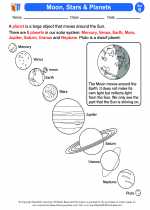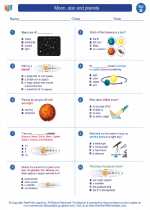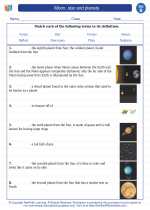Moon, star and planets -> gases
Gases
Gases are one of the three common states of matter, along with solids and liquids. Unlike solids and liquids, gases have no fixed shape or volume. They expand to fill the entire space available to them, and their molecules are in constant, random motion. Gases are all around us, making up the Earth's atmosphere and being produced as byproducts of many chemical and biological processes.
Properties of Gases
Gases have several unique properties that distinguish them from solids and liquids:
- Expansion: Gases uniformly fill any container they are placed in, taking the shape of the container.
- Compressibility: Gases can be easily compressed into smaller volumes by applying pressure.
- Diffusion: Gases mix evenly and completely with other gases due to their random motion and high kinetic energy.
- Low Density: Gases have much lower density than solids and liquids.
- Pressure: Gas particles exert pressure on the walls of their container due to their constant motion and collisions.
Behavior of Gases
Gases follow specific laws and principles that govern their behavior. The three main gas laws are:
- Boyle's Law: States that at constant temperature, the volume of a given amount of gas is inversely proportional to the pressure applied to it.
- Charles's Law: States that at constant pressure, the volume of a given amount of gas is directly proportional to its absolute temperature.
- Gay-Lussac's Law: States that the pressure of a given amount of gas is directly proportional to its absolute temperature when the volume is held constant.
Common Gases
There are several common gases that are encountered in everyday life and have important industrial and environmental roles. Some of these include:
- Oxygen (O2): Essential for respiration and combustion.
- Nitrogen (N2): Makes up the majority of Earth's atmosphere and is important for the growth of plants and animals.
- Carbon Dioxide (CO2): Produced during respiration and combustion, and is a major greenhouse gas.
- Hydrogen (H2): Used in various industrial processes and as a fuel.
- Helium (He): Used in balloons, airships, and cryogenics.
Study Guide
To study gases effectively, it's important to understand their properties, behavior, and common uses. Here are some key points to focus on:
- Define the properties of gases and explain how they differ from solids and liquids.
- Describe the behavior of gases and the relationships described by Boyle's Law, Charles's Law, and Gay-Lussac's Law.
- Identify and explain the roles and uses of common gases in everyday life and industry.
- Explore the effects of gases on the environment, including their contributions to air pollution and climate change.
- Conduct experiments to observe the properties and behavior of gases, such as diffusion, pressure changes, and volume changes.
Understanding the properties and behavior of gases is essential for comprehending the physical world around us and for various scientific and industrial applications.
[Gases] Related Worksheets and Study Guides:
.◂Science Worksheets and Study Guides Second Grade. Moon, star and planets

 Activity Lesson
Activity Lesson
 Worksheet/Answer key
Worksheet/Answer key
 Worksheet/Answer key
Worksheet/Answer key
 Worksheet/Answer key
Worksheet/Answer key
 Vocabulary/Answer key
Vocabulary/Answer key
 Vocabulary/Answer key
Vocabulary/Answer key
